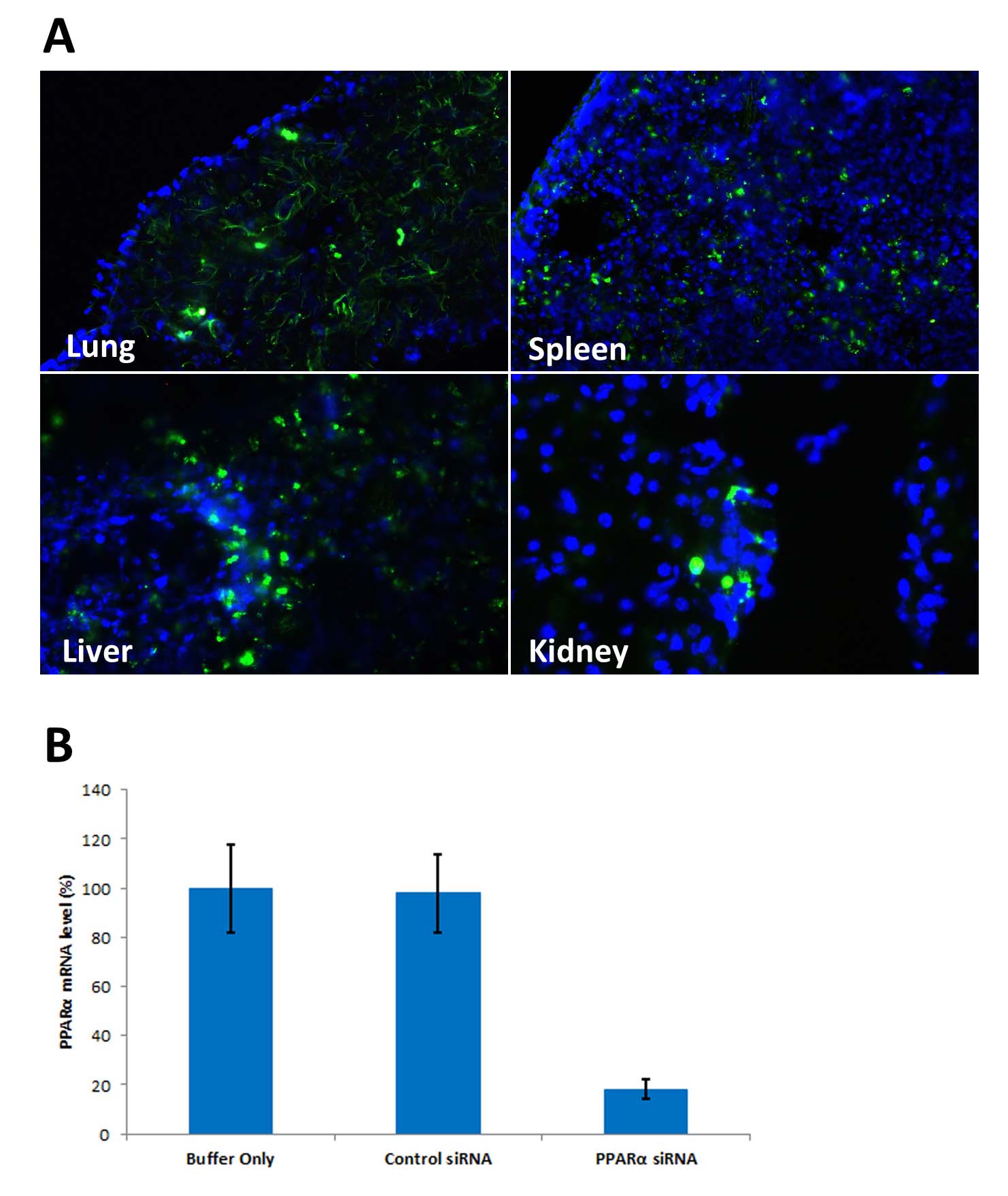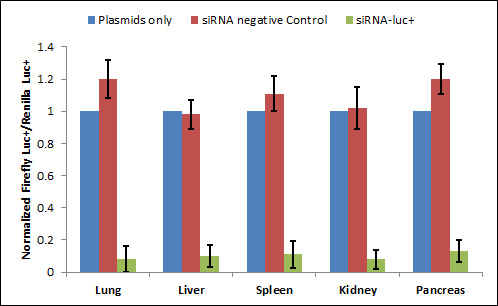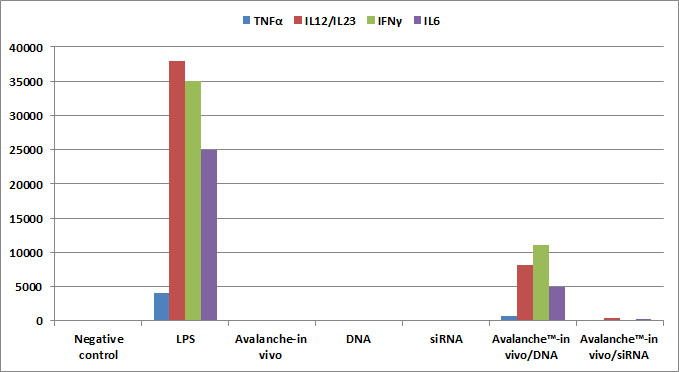
Transfection-EZ Biosystems: Broad Range Transfection Reagents
We offer a range of EZ Biosystems' general purpose transfection reagents for plasmid, siRNA, co-transfections, in vivo work and CRISPR. These reagents are cost-effective and have been specially formulated for maximum transfection efficiency of a wide range of different cell types with minimal toxicity.
Avalanche® transfection reagents have the broad spectrum for
the transfection of large plasmid, mRNA, siRNA, and/or other type of
nucleic acids. This feature makes Avalanche® transfection reagents the
best option for co-transfection of different type and/or size of nucleic
acids. The following are the reasons for the broad spectrum:
The
key components of Avalanche® transfection reagents are mixtures of
cationic lipids and cationic polymers, which contain all three types of
amines: primary, secondary, and tertiary amines. The three types of
amines have different positive charge strength, hence have different
capabilities to combine with negative charged anions.
As anions, different types and sizes of nucleic acids have different densities and quantities of negative charges.
With
optimized ratios of different cationic lipids and polymers, hence
optimized ratios of the three different type of amines, together with
optimized protocols, our Avalanche® mixtures have the optimized strength
of positive charges that ensure them to efficiently combine with
different type of nucleic acids of a variety of negative charge
densities and quantities, and compact them into the right sizes of
nanoparticles with the right densities of positive charge (zeta
potential) on their surface. The optimized size and the right strength
of zeta potential of the nanoparticles are the keys for the
nanoparticles to interact efficiently with negatively charged cell
surface, and trigger endocytosis process.
Avalanche-in vivo Transfection Reagent
Avalanche®-in vivo Transfection Reagent is extremely powerful for gene functional studies and RNA interference in vivo. This reagent was made by our proprietary formula which interacts with nucleic acids, and move into cells via endocytosis. In addition to efficiently transporting nucleic acids into the cells, the formula is also able to lead to the protection of the nucleic acids from lysosomal degradation and the efficient release of those nucleic acids from lysosomes to ensure maximum function. Avalanche®-in vivo has been proven to be able to perform the maximum delivery of DNA, shRNA, siRNA, or oligonucleotides into different organs in the body. No significant pro-inflammatory responses have been detected using this reagent. Avalanche®-in vivo can be administered via various routes, such as intravenous, intraperitoneal, intratumoral injection, etc. Avalanche®-in vivo Transfection Reagent is the best choice for delivering nucleic acids in vivo.
EZ Biosystems
Description
Avalanche®-in vivo Transfection Reagent is extremely powerful for gene functional studies and RNA interference in vivo. This reagent was made by our proprietary formula which interacts with nucleic acids, and move into cells via endocytosis. In addition to efficiently transporting nucleic acids into the cells, the formula is also able to lead to the protection of the nucleic acids from lysosomal degradation and the efficient release of those nucleic acids from lysosomes to ensure maximum function. Avalanche®-in vivo has been proven to be able to perform the maximum delivery of DNA, shRNA, siRNA, or oligonucleotides into different organs in the body. No significant pro-inflammatory responses have been detected using this reagent. Avalanche®-in vivo can be administered via various routes, such as intravenous, intraperitoneal, intratumoral injection, etc. Avalanche®-in vivo Transfection Reagent is the best choice for delivering nucleic acids in vivo.
Features:
-
Efficient delivery of DNA, shRNA, siRNA or oligonucleotides in vivo
-
200 µl reagent for 20 transfections in mouse
-
Efficient delivery to the lung, liver, kidney, and spleen, liver, pancreas and certain type of tumor via systemic administration
- Delivery via Multiple modes of administration in many species
- Avalanche®-in vivo/nucleic acid conjugated complexes are stable in serum for 16h
- No detectable inflammatory responses
- Efficient siRNA and plasmid DNA delivery via direct subcutaneous tumor injection (multiple tumor types)
- Reproducible results
- Applicable for plasmid DNA/siRNA co-injection
- Developed and manufactured by EZ Biosystems LLC
Data:
 |
| Figure 1. Avalanche®-in vivo Transfection Reagent performs high transfection efficiency in vivo. (A). Avalanche®-in vivo Transfection Reagent successfuly delivered EGFP expression vectors into diffeent organs via systemic administration (tail vein). 48 hours post transfection, different organs were harvested. Frozen sections revealed EGFP positive cells. DAPI was used to stain nucleus. (B)In vivo RNAi test: Systemic administration (i.v.) of Avalanche®-in vivo Transfection Reagent conjugated with siRNA targeting PPARa mRNA or non-silencing control siRNA (30 µg/mouse) following the recommended protocol. Liver was collected and RNA isolated 24 hours after first injection. Samples were analyzed by qRT-PCR for PPARa mRNA expression levels. Ribosomal RNA levels were used to normalize the PPARa mRNA data. Data are means /- SD (n=6). |
| |
 |
| Figure 2. Co-transfection application: RNA interference in organs of mice after transfection of siRNA using Avalanche®-in vivo Transfection Reagent. Mice were co-injected with the pGL3 control vector and pRL-SV40 plasmids (Promega) alone or together with siRNAs. The two plasmids contain genes of P. pyralis luciferase (Pp-luc ) and R. reniformis luciferase (Rr-luc) respectively. In all cases, the ratio of Pp-luc to Rr-luc activities was calculated to compensate for differences in transfection efficiencies between mice. The ratios were then normalized to those observed in mice receiving no siRNA. Blue bars, red bars, and green bars indicate normalized Pp-luc /Rr-luc activity ratios in mice receiving plasmids only, in controls co-injected with siRNA-EGFP, and in those co-injected with siRNA-luc respectively (References method: Lewis et al., Nature Genetics 32: 107-8, 2002, but used Avalanche®-in vivo Transfection Reagent for transfection). |
| |
 |
|
Figure 3. Avalanche®-in vivo does not cause any significant pro-inflammatory responses: Serum concentration of TNF-a, IL12/IL23, IFNr and IL6 following intravenous nucleic acid delivery using Avalanche®-in vivo Transfection Reagent 6 h after delivery. The negative control consists of an IV injection of 5% glucose; the positive control an IP injection of 50 µg LPS. 40 µg DNA and 40 µg siRNA were delivered with or without Avalanche®-in vivo Transfection Reagent.
|
Protocol
MSDS
If you cannot find the answer to your problem then please contact us or telephone +44 (0)1954 210 200
Protocols
Download protocol here
If you cannot find the answer to your problem then please contact us or telephone +44 (0)1954 210 200